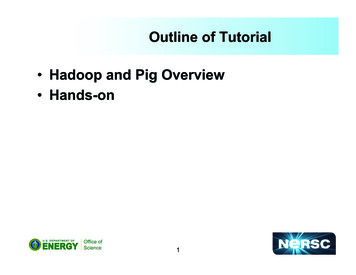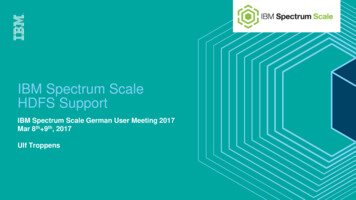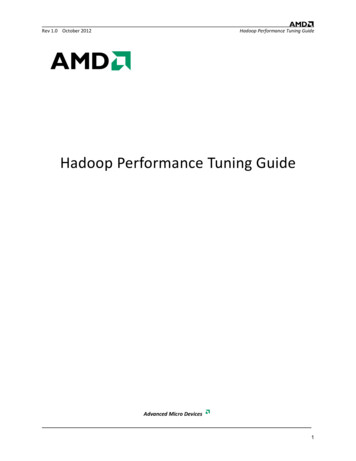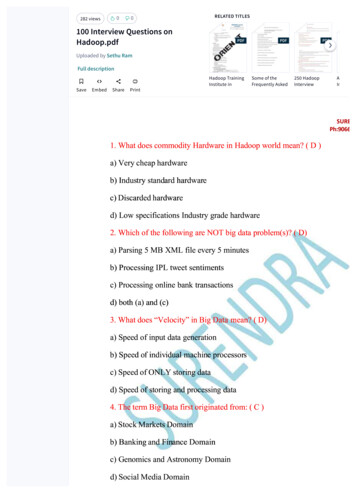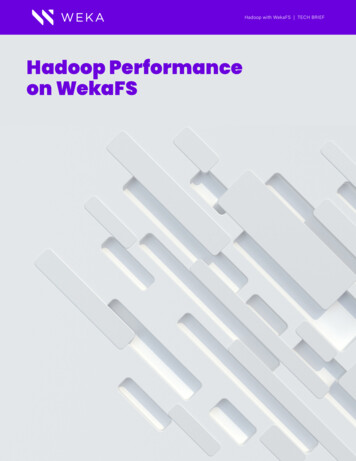
Transcription
Hadoop with WekaFS TECH BRIEFHadoop Performanceon WekaFS
Hadoop with WekaFS TECH BRIEFSUMMARYHadoop and Spark are frameworks that are widely used for processing Big Data in a distributed environment. The Hadoopframework was built as a shared-nothing standalone architecture that relies heavily on data locality to improve performance.Data locality is the notion that data is processed on the local HDD/SSD inside the server to avoid/alleviate network traffic. Whilethis may work well for small environments, it is cumbersome to manage at scale because complete compute nodes have to beadded in order to increase available capacity. In addition, the data cannot be shared with other applications and analytics tools; soHadoop becomes an island of storage that requires back and forth copying of data to and from other application data repositories.WekaIO can remove this constraint by allowing all of the user applications to access a single namespace. This is done by usingthe Weka file system (WekaFS ) POSIX client to access the data store instead of relying on dedicated Hadoop nodes utilizingHDFS. The result is a single data set that improves performance, eliminates copying of data, and optimizes cost, as customers nolonger have to manage multiple storage clusters.WHAT IS HDFS?HDFS (Hadoop Distributed File System) is a storage system used by several applications, including Hadoop, to implement adistributed file system (FS) for parallel data access across scalable clusters. HDFS was originally architected to leverage low-costhardware that frequently crashed, and to minimize network traffic by performing all tasks locally on the node that possesses thedata. HDFS is not a Portable Operating System Interface (POSIX) compliant file system, which means that data stored in the HDFSformat cannot be shared with other applications that expect POSIX file semantics. With HDFS, data cannot be accessed by simplymounting the file system as a POSIX file system; instead, data is accessed via an API or via CLI tool.HADOOP SUPPORT FOR POSIX FILE SYSTEMSHadoop has the ability to mount directly to a POSIX file system “out-of-the-box”. To access data in this manner, use Hadoop’s builtin connector to POSIX file systems called LocalFileSystem.Any Hadoop application can use LocalFileSystem to access WekaIO’s global namespace, removing the need for a dedicatedHadoop/ HDFS cluster. LocalFileSystem can be mounted as a POSIX file system (FS) that will be recognized by the applicationsEnabling LocalFileSystem support requires a code change to use a local path:Replace hdfs path (starting with hdfs://) with local path (starting with file://)BENEFITS OF WEKAFSNO TRIPLE REPLICATION REQUIREDHDFS utilizes triple replication for data protection, which becomes prohibitively expensive when high performance storage mediasuch as NVME or Flash is required to drive performance and reduce latency. WekaFS eliminates the need for three data copies as itemploys a form of erasure coding that delivers significantly better capacity utilization. The WekaFS mount not only replaces HDFS asthe shared FS, but also provides efficient distributed data coding. Capacity utilization jumps from 33.3% to over 70%.DATA SHARING ACROSS APPLICATIONSHadoop clusters typically operate as stand-alone application clusters that perform business critical tasks required for further workflowneeds. Other applications may need this data, requiring a full data copy and doubling storage costs. Weka’s POSIX file system allowsmultiple applications to access a single copy of data reducing storage resource needs. This reduces cost and saves time as data doesnot need to be replicated across islands of storage.
Hadoop with WekaFS TECH BRIEFHUGE PERFORMANCE GAINSThe Weka file system running on NVMe accelerated flash delivers significant performance gains for Hadoop environments. As thefollowing benchmark results show, WekaFS running on virtualized environment in AWS on a minimal 8 node cluster achieved 28GB/sec read performance and 12GB/sec write performance.WekaFS OPERATIONS (OPS) TESTING ENVIRONMENTThe following section provides insight into WekaFS performance for a Hadoop cluster mounted presented as a local mount.For testing Hadoop performance on WekaIO, the following environment was created in Amazon AWS:WekaIO Storage Cluster: x8 i3en.12xlarge instances running WekaFS version 3.6.2Hadoop cluster: x16 c5n.18xlarge instancesHadoop: Ambari version 2.7.0.0, HDFS 3.1.1, YARN 3.1.1, MapReduce2 3.1.1, Tez 0.9.1, ZooKeeper 3.4.0ENVIRONMENT SETUPBenchmarks were run in two scenarios with Hadoop on weka:1.2.Benchmark is run against HDFS which is configured to run from the Weka file system, WekaFSBenchmark is run directly against WekaFSFor each of the 16 hadoop members, a 4TB file system was created in Weka. Each file system was then mounted to /mnt/storage oneach host. Additionally, a 10TB, shared Weka file system was mounted to /mnt/weka of each host.BENCHMARKSWORDCOUNTThe following example wordcount was run from the Weka file system on a 300GB Wikipedia archive (https://engineering.purdue.edu/ puma/datasets.htm) which completed in 122 seconds:time hadoop jar -187.jar wordcount \-Dmapreduce.map.log.level INFO \-Dmapreduce.reduce.log.level INFO \-Dyarn.app.mapreduce.am.log.level INFO \-Dio.file.buffer.size 131072 \-Dmapreduce.map.cpu.vcores 4 \-Dmapreduce.map.java.opts -Xmx3276m \-Dmapreduce.map.maxattempts 1 \-Dmapreduce.map.memory.mb 4096 \-Dmapreduce.map.output.compress true \-Dmapreduce.map.output.compress.codec org.apache.hadoop.io.compress.Lz4Codec \-Dmapreduce.reduce.cpu.vcores 2 \-Dmapreduce.reduce.java.opts -Xmx6553m \-Dmapreduce.reduce.maxattempts 1 \-Dmapreduce.reduce.memory.mb 8192 \-Dmapreduce.task.io.sort.factor 300 \-Dmapreduce.task.io.sort.mb 384 \
Hadoop with WekaFS TECH BRIEF-Dyarn.app.mapreduce.am.command.opts -Xmx6553m \-Dmapreduce.input.fileinputformat.split.minsize 536870912 \-Dyarn.app.mapreduce.am.resource.mb 4096 \-Dmapred.reduce.tasks 200 \file:///mnt/weka/hdp/wiki/wikipedia 300GB/OUTPUT file:///mnt/weka/hdp/wiki/ wikipedia 300GB RANDOM RESULTSFILE 2 &1GB/secThe job completed in 126 seconds during which we saw a peak of 11.6GB/sec reads and a peak of just over 2GB/sec writes:GREP MRUsing the same 300GB Wiki archive, the following MR grep was run against a non-existent string oop jar -187.jar grep \-Dmapreduce.map.log.level INFO \-Dmapreduce.reduce.log.level INFO \-Dyarn.app.mapreduce.am.log.level INFO \-Dio.file.buffer.size 131072 \-Dmapreduce.map.cpu.vcores 4 \-Dmapreduce.map.java.opts -Xmx3276m \-Dmapreduce.map.maxattempts 1 \-Dmapreduce.map.memory.mb 8192 \-Dmapreduce.map.output.compress true \-Dmapreduce.map.output.compress.codec org.apache.hadoop.io.compress.Lz4Codec \-Dmapreduce.reduce.cpu.vcores 2 \-Dmapreduce.reduce.java.opts -Xmx6553m \-Dmapreduce.reduce.maxattempts 1 \-Dmapreduce.reduce.memory.mb 4096 \-Dmapreduce.task.io.sort.factor 300 \
Hadoop with WekaFS TECH BRIEF-Dmapreduce.task.io.sort.mb 300 \-Dyarn.app.mapreduce.am.command.opts -Xmx6553m \-Dmapreduce.input.fileinputformat.split.minsize 268435456 \-Dyarn.app.mapreduce.am.resource.mb 4096 \-Dmapred.reduce.tasks 200 \file:///mnt/weka/hdp/wiki/wikipedia 300GB/file:///mnt/weka/hdp/wiki/wikipedia 300GB RANDOM/f2fa8586f061b9fc72dc6c05b0b7d5cf6eb5b78b RESULTSFILE 2 &1GB/secThis job completed in 68 seconds and saw peak reads of 25GB/sec from the Weka storage:TERAGENTeragen was used to write 400GB of data to the Weka file system:hadoop jar -187.jar teragen \-Dmapreduce.map.log.level INFO \-Dmapreduce.reduce.log.level INFO \-Dyarn.app.mapreduce.am.log.level INFO \-Dio.file.buffer.size 131072 \-Dmapreduce.map.cpu.vcores 2 \-Dmapreduce.map.java.opts -Xmx3276m \-Dmapreduce.map.maxattempts 1 \-Dmapreduce.map.memory.mb 4096 \-Dmapreduce.map.output.compress true \-Dmapreduce.map.output.compress.codec org.apache.hadoop.io.compress.Lz4Codec \-Dmapreduce.reduce.cpu.vcores 2 \-Dmapreduce.reduce.java.opts -Xmx6553m \-Dmapreduce.reduce.maxattempts 1 \-Dmapreduce.reduce.memory.mb 8192 \
Hadoop with WekaFS TECH BRIEF-Dmapreduce.task.io.sort.factor 300 \-Dmapreduce.task.io.sort.mb 384 \-Dyarn.app.mapreduce.am.command.opts -Xmx6553m \-Dyarn.app.mapreduce.am.resource.mb 8192 \-Dmapred.map.tasks 200 \4000000000 400G RESULTSFILE 2 &1GB/secThis job completed in 68 seconds and held a write throughput greater than 8GB/sec throughout:TERASORTTerasort looks to be tightly coupled with HDFS 528) and we were unableto run it directly on Weka. However, we did run Terasort on HDFS running from Weka file systems:hadoop jar -187.jar terasort \-Dmapreduce.map.log.level INFO \-Dmapreduce.reduce.log.level INFO \-Dyarn.app.mapreduce.am.log.level INFO \-Dio.file.buffer.size 131072 \-Dmapreduce.map.cpu.vcores 4 \-Dmapreduce.map.java.opts -Xmx3276m \-Dmapreduce.map.maxattempts 1 \-Dmapreduce.map.memory.mb 4096 \-Dmapreduce.map.output.compress true \-Dmapreduce.map.output.compress.codec org.apache.hadoop.io.compress.Lz4Codec \-Dmapreduce.reduce.cpu.vcores 2 \-Dmapreduce.reduce.java.opts -Xmx6553m \-Dmapreduce.reduce.maxattempts 1 \-Dmapreduce.reduce.memory.mb 8192 \-Dmapreduce.task.io.sort.factor 300 \-Dmapreduce.task.io.sort.mb 384 \-Dyarn.app.mapreduce.am.command.opts -Xmx6553m \-Dmapreduce.input.fileinputformat.split.minsize 1073741824 \
Hadoop with WekaFS TECH BRIEF-Dyarn.app.mapreduce.am.resource.mb 8192 \-Dmapred.reduce.tasks 230 \-Dmapreduce.terasort.output.replication 1 \/home/hdfs/teragen/1T-terasort-input /home/hdfs/teragen/1T-terasort-output RESULTSFILE2 &1GB/secTerasort ran with 1TB of data and completed in 9 minutes and 8 seconds. This workload hit a peak of 27GB/sec reads and a peakof 12GB/sec writes.SUMMARYThis document demonstrates that WekaFS provides very high throughput per nodes from a minimal 8 node cluster running on ashared virtualized network in AWS across a range of the Hadoop. Typically Weka sees an order of 2x performance improvementrunning on bare metal instances on industry standard hardware from vendors such as Supermicro, Dell or HPE. For Wordcount, WekaFS delivered 725MB/second per Hadoop node from a minimum cluster size of Weka on 8 nodes acrossAWS virtualized environment, for a peak of 11GB/sec read performance. For MapReduce GREP, WekaFS delivered in excess of 25GB/sec across the 16 Hadoop nodes, completing in 68 seconds. For TeraGen, WekaFS delivered 8GB/sec write performance across the 16 Hadoop nodes, also completing in 68 second. For TeraSort, due to tight coupling with HDFS, the benchmark was run on HDFS running on the Weka file system. The peakperformance was 28GB/second reads and 12GB/sec writes.The Weka file system will deliver very efficient performance per storage node, ensuring that clients can complete tasks quickly.Leveraging a shared file system vs. typical Hadoop nodes, performance scaling can occur independently for the Hadoop nodesand the storage system without the need for tight coupling of the two.Weka offers the additional ability to scale the data lake by extending the name space from the flash tier to object tier, allowing thedata lake to scale to Petabytes, without the need to scale out the Hadoop cluster.910 E Hamilton Avenue, Suite 430, Campbell, CA 95008T: 408.335.0085E: info@weka.iowww.weka.io 2019-2021 All rights reserved. WekaIO, WekaFS, Weka AI, Weka Innovation Network, Weka Within, the Weka brand mark, the WIN andWeka logos, Limitless Data Platform, and Radically Simple Storage are trademarks of WekaIO, Inc. and its affiliates in the United States and/or other countries. Other trademarks are the property of their respective companies. References in this publication to WekaIO’s products,programs, or services do not imply that WekaIO intends to make these available in all countries in which it operates. Product specificationsprovided are sample specifications and do not constitute a warranty. Information is true as of the date of publication and is subject to change.Actual specifications for unique part numbers may vary.W03R2TB202102
sec read performance and 12GB/sec write performance. WekaFS OPERATIONS (OPS) TESTING ENVIRONMENT The following section provides insight into WekaFS performance for a Hadoop cluster mounted presented as a local mount. For testing Hadoop performance on Wek


